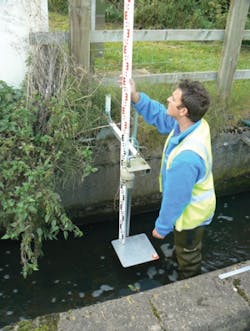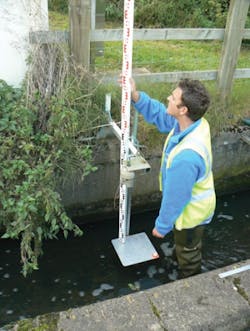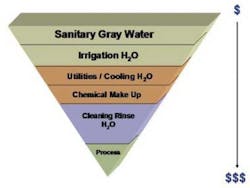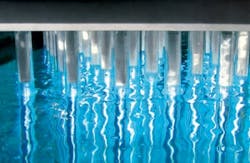Clearing Covert Culverts To Beat Flooding
Severe flooding has devastated parts of the UK, with estimates suggesting the 2007 floods cost the country a total of £3.2 billion. Keeping culverts clear is one method to ensure surface water and storm water flows are maintained, says Ian Clarke.
Much of the focus of water industries is aimed at projects and products related to either potable water supply or foul/wastewater removal. However, the increasing likelihood of heavy rainfall, boosted by arguments for the effects of climate change, have raised the need to ensure that culverts and other drainage systems handling surface water and storm water flows are maintained. It is important to keep such systems at their best. Maximum flow-handling condition of such systems can help safeguard against future potential flooding events.
In the past few years, we have seen major flooding incidents in the UK, with increasing concern among environment agencies, local authorities and the general public that the removal of surface water is not the priority it should be. Some of these incidents have highlighted the need to ensure that culverts, in particular those established to manage flows beneath vital infrastructure such as roads and railways and those that divert flows to protect housing and businesses, are maintained at the highest level.
One problem is that the complete replacement of many of these culverts is impractical due to their location in relation to infrastructure. With this in mind, many authorities have commissioned major culvert investigation and rehabilitation programmes. These aim to bring existing culverts to full operating capacity and ensure that they remain a key part in countrywide flood defences.
So what are the options available?
In the UK, there is a wide variety of potential techniques available to complete rehabilitation. This is mainly driven by the wide variety of clientele with culvert structures in their area of responsibility, including the likes of the Environment Agency, British Waterways, the Highways Agency, local authorities and Network Rail. All of these companies, agencies and local governments have varying degrees of deterioration and structural integrity problems.
Of course the simplest rehabilitation technique is to clean the culvert out. In many instances simply removing the blockage is sufficient to bring the culvert back to full operational readiness. In many other circumstances, however, the age of the culvert, the original construction materials used and minimal care over the years requires further techniques.
Standard cured-in-place pipe (CIPP) lining using hot water and steam cure options
Standard CIPP liners comprise resin impregnated needle felt material, which is generally inverted into the host culvert using water pressure or compressed air, depending on the curing process being used, from a scaffold tower or inversion drum/CHIP unit. Hot water is circulated or steam is passed through the inverted liner curing the resin and completing the installation.
The recent introduction of Insituform Technologies' (ITL) iPlus Composite inversion liner system has made it possible to complete similar linings with a thinner product, while providing the same or stronger structural lining due to the inclusion of high strength reinforcing fibres in the fabric of the liner during its manufacture.
Reinforcing fibres integrated into the pipe wall form a laminated sandwich structure with improved physical properties.
Glass reinforced plastic (GRP) pre-manufactured lining
GRP lining is classed as a segmental lining system, meaning it uses preformed/prefabricated liner sections as the basis of the lining system. A GRP liner is essentially a fibreglass/resin product which is factory manufactured and moulded to the precise size and shape of the pipeline it is designed to rehabilitate. The design is normally based on the minimum dimension permissible within the deteriorated culvert under repair. This ensures that the liner can be installed throughout the culvert length without any deformation in the host pipe that prevents access. GRP liners can also be used to negotiate bends in culverts by using short length liner pipes.
As the GRP liner segments are preformed to the minimum dimension of the host pipe, installation is normally achieved manually with specially fabricated end profiles. This links together closely to ultimately form the completed lining length.
Within the culvert, the liner segments are positioned using spacer blocks to create the lining, with an annulus between the liner outer wall and the pipe inner wall. Normally this annulus is grout filled as the lining construction advances. This provides the necessary bond between the host pipe and the new liner and adds to the structural integrity of the completed system.
Injection sealing
The Intergrout renovation system seals all leaks and restores the compressive ring strength of brick and masonry arches. A man-entry technique, this method of filling the cracks and voids with high strength polymer-reinforced grout has been proven to be effective in all sizes of sewer. It is a cost-effective solution to problems caused by erosion and the breakdown of the original structure. Installation is completed by drilling small diameter holes into the liner wall and injection grout is then used to voids around and within the culvert structure forming the required seal.
Where injection sealing is not required but where there is deterioration in the culvert wall due to misplaced mortar or missing brickwork, re-pointing and brick replacement can be used.
Ferro-cement
Ferro-cement lining uses a mesh support structure that is normally constructed within the host pipe/culvert at the section to be lined. A special cement mortar is applied to create the ferro-cement structure. The system creates a WRc Type I liner once cured. Advantages of this system are that it can be used to repair discreet/localised sections of a pipe such as the invert section if this is where the pipe's problem is located. It is also suitable to complete ‘whole pipe' linings.
Recent projects
ITL recently embarked on a project to rehabilitate a culvert system in Ottery St. Mary, Devon in South West UK. The culvert in question, known as the Ottery culvert, originally built in the late 1800s, was believed to be the problem behind extensive past flooding. This was as a direct result of the limitations of capacity of the brick culvert designed to carry a water course beneath the town. As population and highway traffic increased over the years, the old watercourse was typically placed in extensions to the culvert to allow town development to continue. The culvert took the form of a shallow brick arch following the meandering line of the original stream running the length of the town.
Ottery St. Mary is a thriving small town with narrow, winding streets. Although busy throughout the year, extensive traffic build-up occurs during the tourist season. In some sections, the culvert carrying the watercourse had been built over. In view of this, the construction of a culvert of sufficient capacity (calculated to be a culvert with a minimum of 1.35m2 cross-sectional area) was needed to eliminate future flooding risk. This presented major problems given the constraint of the need to minimise surface disruption.
The existing culvert varied in dimension and form of construction but over the majority of its length are high side walls 400mm high. These were built with a mix of stone and brickwork.
While the lower sections of the culvert were to be replaced using open cut techniques through a wide roadway and car park, construction of the upper reaches of the culvert, which passed under the town centre and in some cases directly under existing buildings, presented more difficult and potentially more costly problems, all with disruptive consequences to traders and town traffic.
Working in close association with the Environment Agency's design engineers, WS Atkins, and the partnering contractors, Van Oord/TJ Brent, ITL prepared a less disruptive solution for construction: a three-segment GRP based system Insituplate.
On a further culvert rehabilitation contract, Bristol Water, through its main contractor, Costain, was required to renovate an existing raw water culvert taking feed from reservoirs at Chew Magna and others in the Mendips to its Barrow Treatment Works. The water is conveyed mainly in masonry culvert with sections of aqueduct which cross valleys enroute. The total length of the culvert is approximately 20km. Since the late 1980s, Sewer Services and latterly Insituform Sewer Services have renovated various sections of the culvert.
The latest culvert section to be renovated was a 680m length at Litton. This culvert was nominally a 1,380mm x 1,095mm masonry egg shape which was rehabilitated with a 1,264mm x 960mm GRP egg-shaped liner. The resultant annulus was grouted with a PFA/Cement grout.
Some 160 tonnes of grout was required to fill the annulus created across the project length. The purpose of the project was to renovate the old structure which suffered from the partial collapses and exfiltration of water.
Author's note:The article was prepared for Insituform Technologies by Ian Clarke, NoDig Media Services. For further information please email: [email protected]
More Water & WasteWater International Current Issue Articles
More Water & WasteWater International Archives Issue Articles



